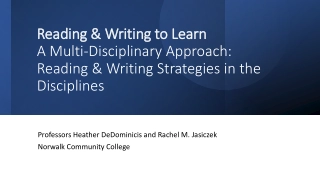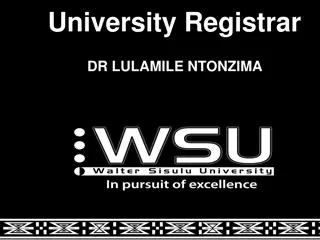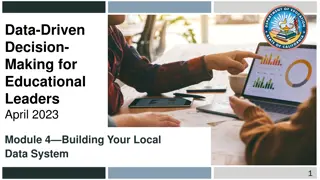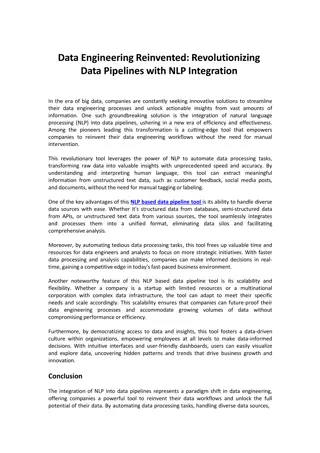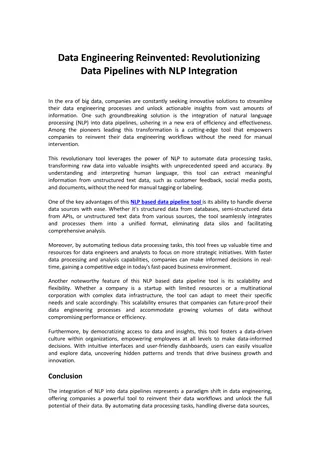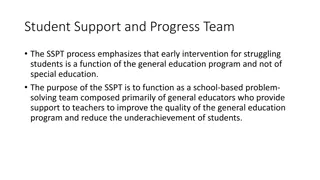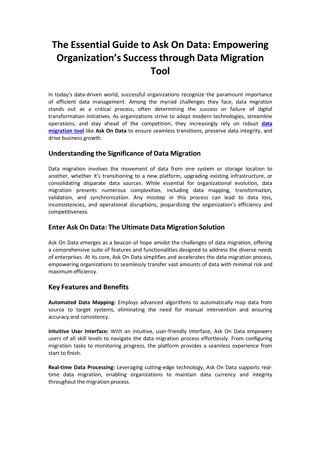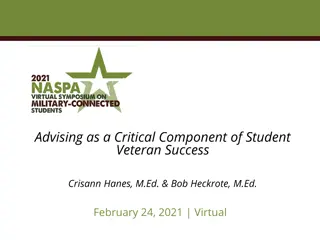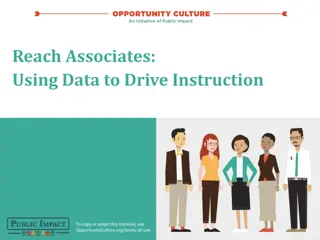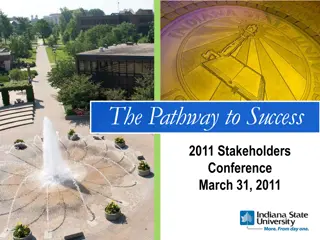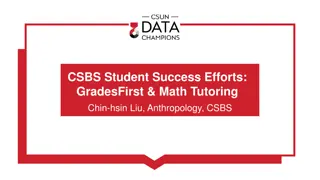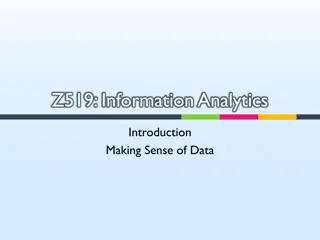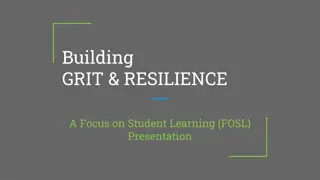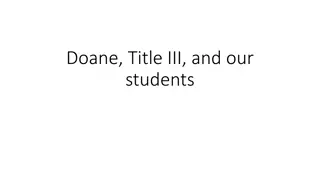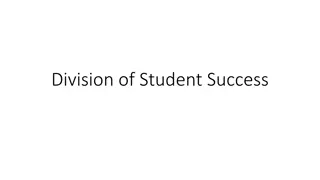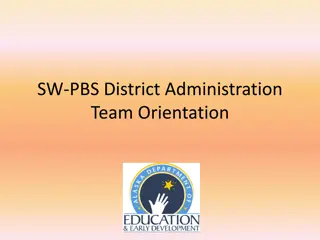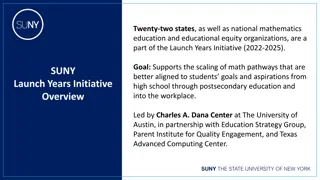Enhancing Student Success Through Data-Driven Strategies
Today's presentation highlights our integrated plan for 2017 based on data-driven insights and a commitment to equity. We share our goals to improve completion, retention, professional development, data-based inquiry, and student engagement. The approach is focused on developing a theory of action from the data and prioritizing impact for students with the greatest need. Specific goals include increasing completion rates for math and English, enhancing professional development for an equity lens, implementing annual data-based inquiry, and improving student engagement. The presentation underscores the importance of using data to drive decisions and create scalable impact.
Download Presentation

Please find below an Image/Link to download the presentation.
The content on the website is provided AS IS for your information and personal use only. It may not be sold, licensed, or shared on other websites without obtaining consent from the author. Download presentation by click this link. If you encounter any issues during the download, it is possible that the publisher has removed the file from their server.
E N D
Presentation Transcript
Todays Presentation: INTEGRATED PLAN, 2017. OUR DATA. 1. Share data and process that informed our goals 2. Share our goals 3. Solicit your feedback!
Where did you get that from? Where did you get that from? Quantitative Data: MIS Data Mart (Scorecard), Colleague, Basic Skills Cohort Tracker, Cabrillo College Fact Book Qualitative Data: RP Student Support Redefined, Committee and stakeholder input Worked extensively with PRO
Our Approach and Framework: Our Approach and Framework: Data Driven, developing a theory of action based on our data Equity-mindedness as our guiding paradigm for language and action Accountable to all, but focused on: Greatest impact, for the greatest amount of students, with the greatest need. Scalable impact through scalable activities
Our 5 Goals Our 5 Goals- -Short and Sweet! Short and Sweet! 1: IMPROVE COMPLETION Guided Pathways (GP) Pillar #3, Staying on the Path Increase completion of math and English within first and second year Increase completion of certificate, degree, and transfer readiness 2: IMPROVE RETENTION GP #3 - Staying on the Path Focus on academic and progress disimissal 3: ENHANCE PROFESSIONAL DEVELOPMENT TO DEVELOP A CAMPUS-WIDE EQUITY LENS GP #1, #2, #3, #4 4: IMPLEMENT ANNUAL DATA-BASED INQUIRY GP #1, #2, #3, #4 5: IMPROVE STUDENT ENGAGEMENT GP #3: Staying on the Path
Our Approach Our Approach Data Data- -based Inquiry based Inquiry
GOAL 1: English and Math Completion within 1st and 2nd Year.
MATH success rates: 2012-2015 White MEN higher success rate than African American and Latino MEN TRANSFER LEVEL MATH: 15.8% difference on average White WOMEN higher success rate than African American and Latina WOMEN TRANSFER LEVEL MATH: 16.5% difference on average For TRANSFER LEVEL MATH White MEN and White WOMEN have SIMLAR SUCCESS rates (approximately 40%) Latina and African American WOMEN have the lowest success rate of 18.9% (21% difference to White MEN and WOMEN) Math - 2 year performance based on Economical Disadvantage 2012-13: BOG 23.7%, No BOG 40.4% 16.7% diff. 2013-14: BOG 25.2%, No BOG 37.1% 11.9% diff. 2014-15: BOG 23.7%, No BOG 40.4% 16.7% diff.
ENGLISH success rates: 2012-15 White MEN higher success rates than African American and Latino MEN TRANSFER LEVEL ENGLIGH: 14.8% difference on average White WOMENhigher success rates than African American and Latina WOMEN TRANSFER LEVEL ENGLIGH: 16% difference on average White WOMEN are outperforming all groups, including White MEN Latino and African American MEN have the lowest success rate of 52.3% (23.6% difference to White women) English - 2 year performance based on Economical Disadvantage 2012-13: BOG 57.6%, No BOG 71.0% 13.4% diff. 2013-14: BOG 62.8%, No BOG 69.7% 6.9% diff. 2014-15: BOG 60.0%, No BOG 67.8% 7.8% diff.
GOAL 1: GOAL 1: Degree, Certificate, Degree, Certificate, Transfer readiness Transfer readiness within 6 years within 6 years
6 year completion rates: Fall 2008, Fall 2009, and Fall 2010 entering cohorts: White WOMEN 57.1% White MEN 49.7% Latina and African American WOMEN 37.5% Latino and African American MEN 29.6% White WOMEN have HIGHEST completion rates of all groups Latino and African American MEN have the lowest completion rates (27.5% difference) White WOMEN have higher completion rates than Latina and African American WOMEN (19.6% difference) White MEN have higher completion rates than Latino and African American MEN (20.1% difference)
Goal 2: Retention. Goal 2: Retention. What does Academic Dismissal Tell Us? What does Academic Dismissal Tell Us? Fall 2014-Spring 2017 950 Students
Goal 2: Retention. Goal 2: Retention. What does Academic Dismissal Tell Us? What does Academic Dismissal Tell Us? Women by ethnicity Latina women are placed in Academic Dismissal at rates four times higher than that of White women 388 women In the last 15 years, the Latino student population has been the fastest growing demographic group at Cabrillo increasing 22%
Goal 2: Retention. Goal 2: Retention. What does Academic Dismissal Tell Us? What does Academic Dismissal Tell Us? Between Fall 2014 and Spring 2017 a total of 950 students were flagged as "Academic Dismissal 562 Men Latino males are placed in Academic Dismissal at the highest rate out of all groups and three times higher than their White male counterparts In the last 15 years, the Latino student population has been the fastest growing demographic group at Cabrillo increasing 22%
Takeaway: Takeaway: Race and ethnicity, economic disadvantage, and first generation status matter in student educational outcomes and student experiences
Goal 3 and 5: Improve Campus Climate and Goal 3 and 5: Improve Campus Climate and Student Engagement on campus. Student Engagement on campus. The Student Voice The Student Voice Dusting off the 2015 RP Focus Group Study Study conducted by the RP Group in Spring 2015 7 Focus groups: African American, Native American, Latino/a Aptos, Latino/a Watsonville, ASC, Veterans, Guardian Scholars (FY) 4 Questions: 1. What is it like to be a member of X group at Cabrillo? 2. What personal factors help you overcome these challenges? 3. What is the college doing to help you? 4. What do you need? What can the college do better?
QUESTIONS? QUESTIONS?


